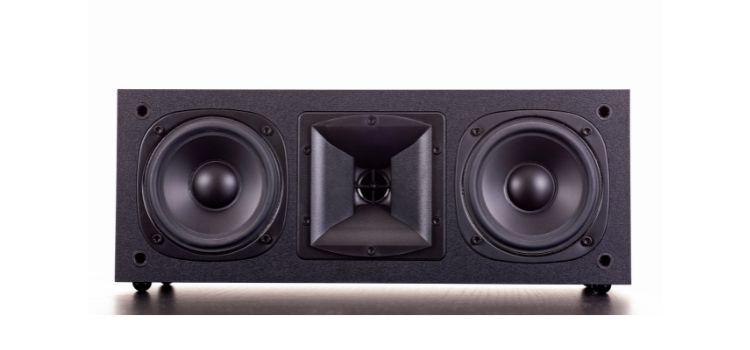Center channel speakers are an integral part of any home theater system. They play a crucial role in reproducing dialogue and film music, providing clarity and detail that other speakers cannot match. But when it comes to frequency response, what is the ideal range for a center channel speaker? In this article, we’ll explore the importance of frequency response in center speakers, the factors that affect it, and how to choose the right center speaker for your home theater system.
Table of Contents
Ideal Frequency Range for Center Channel Speakers

A good frequency response for a center channel speaker would be a range of around 60 Hz to 20 kHz. This is particularly important for dialogue when watching movies and TV shows. The human voice falls within a range of frequencies, and if a center speaker does not reproduce those frequencies accurately, dialogue can sound muddy or unintelligible.
In addition to dialogue, frequency range is also important for accurately reproducing music in movie soundtracks and television. Center channels aren’t solely for reproducing dialogue. Your center channel will reproduce about 70% of all the sound when watching movies and TV. That’s why frequency response beyond just dialogue is necessary.
Although we recommend a center channel that can reach as low as 60 Hz, many use AV crossover settings to limit this. That could mean adjusting settings to only have your center channel reproduce frequencies above 80 Hz. While this is just one example, it’s also largely a preference. It’s normal to experiment with different crossover settings since the dynamics of each room can vary. You’ll also want a subwoofer and capable front speakers to use frequency response crossover settings with the best results.
The Role of Center Speakers in Home Theater Systems
The function of a center channel speaker is crucial in a home theater system. It plays a vital role in reproducing dialogue and film music, making it essential to ensure that the center channel speaker has the right frequency response.
A center channel speaker is the primary source for dialogue in a movie soundtrack. Dialogue in movies is often recorded at a lower volume than other sounds, and if the center channel speaker doesn’t reproduce these sounds accurately, it could result in an unpleasant listening experience.
Additionally, the center speaker is also responsible for reproducing music that is specific to the film. The music is designed to accompany the film’s action and enhance the viewing experience. Therefore, it’s important to ensure that the center channel speaker has the capability to reproduce the full frequency spectrum of the music.
What Sound Is Reproduced By Center Channels?

Your center channel is responsible for an immense amount of sound in your home theater. It’s important to understand the varying type of sound since this dictates the necessary frequency response. You’ll want a center channel that can accurate reproduce these key sounds for the best experience.
The Frequency Spectrum of the Human Voice
To understand the ideal frequency response of a center channel speaker, it’s important to know the frequency spectrum of the human voice. Men’s voices typically range from 85 to 180 Hz, while women’s voices range from 165 to 255 Hz. The fundamental frequency range is where most of the energy in the human voice lies, but there are higher frequencies achieved during speaking, singing, and screaming.
Higher frequencies are essential in reproducing female vocals, as they often have a higher pitch than male vocals. It’s also crucial for reproducing sounds such as footsteps, clothing rustling, and other ambient noises that are present in movie soundtracks.
Film Music and the Need for Higher Frequencies
In addition to dialogue, center channel speakers are also responsible for reproducing film music. Film music is designed to create an emotional response in the viewer, and therefore, it requires a wide frequency range to be fully appreciated.
The frequency range required for film music can range from 20 Hz to 20 kHz, which is the entire range of human hearing. It’s important to note that music with a lot of bass notes will require a center channel speaker that can accurately reproduce lower frequencies without distortion. Anything below 40Hz should realistically be handled by your subwoofer, though.
The center channel speaker’s ability to cover much of the frequency spectrum is crucial in accurately reproducing film music. Without this capability, music can sound muddy, and the listener may miss out on the nuances of the soundtrack.
2-Way Vs 3 Way Center Channel Speakers
You can find popular options for center channels with different designs and configurations. One key difference is that differing driver configurations. While most center speakers have 2-way systems, many opt for 3-way center channels.
2-Way Systems in Center Speakers
One of the most common designs for center channel speakers is the 2-way system, which comprises a tweeter and a midrange driver. The tweeter is responsible for reproducing high-frequency sounds, while the midrange driver handles the lower frequencies.
This design is advantageous in reproducing dialogue, as it allows for clear and accurate reproduction of the human voice. The tweeter is capable of reproducing high-frequency sounds, such as the higher frequencies present in female vocals, while the midrange driver handles the lower frequencies in the voice.
3-Way Systems in Center Speakers
The 3-way system in center speakers is a popular design that includes separate drivers for treble, midrange, and bass frequencies. This type of center speaker is often larger than a 2-way system but offers several benefits for reproducing a wider frequency range. The separate drivers in a 3-way system are each optimized to handle a specific range of frequencies, resulting in improved sound quality and accuracy.
The treble driver is responsible for reproducing high-frequency sounds, while the midrange driver handles the middle range of frequencies. The bass driver is designed to handle the lower frequencies and is usually a larger driver than the other two. Separating the drivers in this way allows each to perform optimally, resulting in a cleaner and more accurate sound.
One potential downside to a 3-way system is that it can be more expensive than a 2-way system. Additionally, it may require more power to drive the separate drivers, which could affect the overall power handling of the speaker. However, for those who prioritize sound quality, a 3-way center speaker is often worth the investment.
Factors Affecting Sound Quality in Center Speakers
There’s more to sound quality than your center channel’s frequency range. Several factors can affect the sound quality of a center speaker, including the speaker’s design, placement, and acoustics of the room. The speaker’s design, including the number and type of drivers, can have a significant impact. A well-designed center speaker will have a smooth and even sound profile, with no significant dips or peaks.
The placement of the center speaker is also important for achieving optimal sound quality. Ideally, the center speaker should be placed at ear level and directly in front of the listener. It should also be positioned at an equal distance from the left and right speakers to create a balanced soundstage. Room acoustics can also play a significant role in a center channel speaker’s frequency range. Large, open rooms with hard surfaces can create echo and reverberation, which can negatively impact sound quality.
Choosing the Right Center Speaker for Your Home Theater System
When choosing a center speaker for your home theater system, it is essential to consider the speaker’s frequency response range. A good frequency response for a center speaker would be around 60 Hz to 20 kHz for most. This covers enough frequencies for dialogue, music, and low frequencies. There’s still room to experiment with crossover settings.
Other factors to consider when choosing a center speaker include the size of the room and the system’s budget. For small rooms, a compact center speaker may be sufficient, while larger rooms may require a larger center speaker to provide adequate sound coverage. Your budget should also be a consideration, with 2-way systems typically being more affordable than 3-way systems.
Conclusion: Center Channel Frequency Range
The center channel speaker plays a vital role in any home theater system, providing accurate sound reproduction for dialogue and film music. When it comes to choosing the ideal center speaker, frequency response is a crucial consideration. It’s important that your center channel captures all the necessary frequencies for the best home theater experience. Frequency response isn’t an indicator of quality though. Ensure to also focus on center channels with good overall sound quality and power.

Keith Collins has been writing for over 15 years for various publications. He’s a lover of music, home theater, and excellent sound quality. His fondness for technology in addition to his non-stop curiosity fuels his writing ventures.